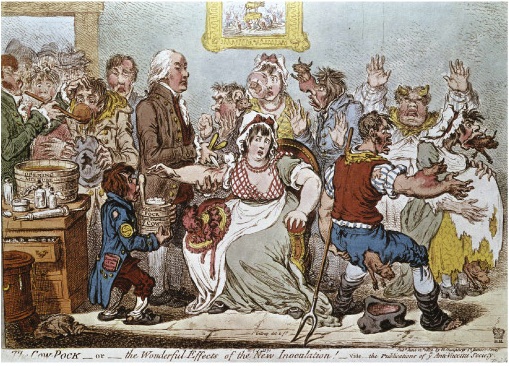2.9 The eradication of smallpox
Jenner’s discovery had relatively little impact on smallpox outbreaks in his lifetime, partly because it proved difficult to generate sufficient quantities of cowpox vaccine in order to vaccinate large numbers of people. Moreover, the method of producing the vaccine in cattle was unreliable and the extracts were often contaminated with other pathogens. Some feared the ‘unnatural’ consequences of a vaccine extracted from cows, as a famous cartoon of the early 19th century illustrates (Figure 11).

Yet despite many setbacks in the intervening years, the last case of naturally transmitted smallpox anywhere in the world occurred in 1977 and in 1980 the World Health Organization (WHO) announced that smallpox had been eradicated globally. Eradication refers to the total elimination of all the infectious agents causing a particular disease in all populations throughout the World. The smallpox virus now only exists in small quantities in secure laboratories and there is controversy about whether even these samples should be destroyed. Smallpox is the first, and so far only, infectious disease to be globally eradicated.
Worldwide success against smallpox so soon after the WHO began its global eradication programme in 1966 raised hopes that mass vaccination would soon ‘win the war’ against other infectious diseases. There are several reasons why it took almost 200 years from Jenner’s first successful vaccination in 1796 to eradicate smallpox. It was not until the 1950s that an effective, stable vaccine derived from a modified pox virus – named vaccinia in honour of Jenner’s discovery – was produced in sufficient quantities for mass vaccination against smallpox. Optimistic predictions about the potential impact of other vaccines failed to take into account the unusual biological conditions that made smallpox uniquely susceptible to eradication.
The special features of the smallpox vaccination campaign that made it so successful can be summarised as follows:
- A single vaccination with vaccinia provokes such a strong protective response that the individual develops lifelong ‘immunity’ to smallpox; most other vaccines require repeated ‘booster’ doses to achieve this level of protection.
- Smallpox viruses survive only in humans – there are no non-human hosts, so there is no ‘reservoir’ of pathogens in other animals that can be transmitted to people; several other major pathogens (e.g. influenza viruses and TB bacteria) are zoonoses, i.e. they can be transmitted from animals to humans.
- Smallpox has such unique, easily recognisable diagnostic signs (Figure 12) that medical expertise is not needed to identify suspected cases, and fear of smallpox strongly motivates community members to report them immediately to the health authorities.
- The characteristic pustules (Figure 12) appear very soon after someone is infected, so they can often be quarantined (isolated) before the infection spreads and their contacts can be identified, vaccinated and kept under surveillance.

